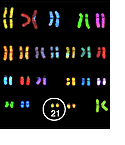|
 Previous Event | Next Event Previous Event | Next Event 
2000: Chromosome 21

In May 2000, Human Genome Project scientists led by German and Japanese teams described the finished genome sequence of human chromosome 21, the second human chromosome to be fully sequenced. An extra copy of chromosome 21 causes Down syndrome and genes on the chromosome have been linked to diseases like Alzheimer’s and certain forms of cancer.
The published sequence contained approximately 33,500,000 base pairs. Chromosome 21 appears to have less than 300 genes.
More Information
Reference:
Hattori, M., Fujiyama, A., Taylor, T.D., Watanabe, H., Yada, T., Park, H-S., Toyoda, A., et al. The DNA sequence of human chromosome 21. Nature, 405: 311-319. 2000. [Full Text] 
To view this PDF, you will need Adobe Reader. 
 Previous Event | Next Event Previous Event | Next Event 
Last Reviewed: April 10, 2008
|

